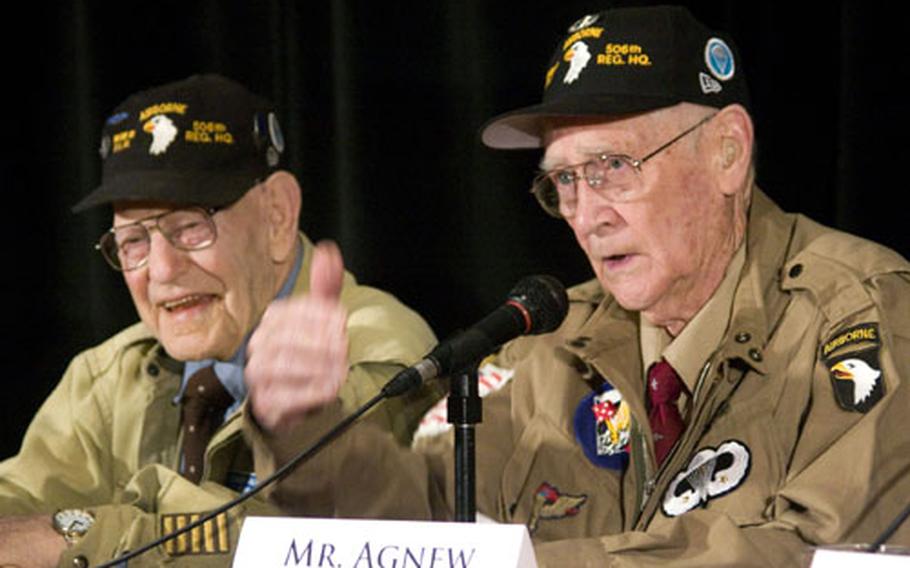
Jake McNiece, left, enjoys the story being told by fellow "Filthy Thirteen" paratrooper Jack Agnew during the American Veterans Center's 2008 annual conference in Washington, D.C. (Joe Gromelski / S&S)
WASHINGTON — Jake McNiece’s story would have made a great movie script. His crew of troublemaking soldiers, the Filthy Thirteen, took on a suicide mission at the height of World War II, pulled it off and lived to tell about it.
It’s almost a shame they made "The Dirty Dozen" instead.
That movie is the very fictionalized account of the unit. The real story doesn’t feature any convicted criminals, any pact against bathing or any NFL stars.
But it does feature a group of young Army paratroopers who parachuted behind enemy lines on D-Day and performed key demolition missions.
And, like their big screen counterparts, they were better known as malcontents before they were known as heroes.
"We weren’t murderers or nothing," said Jack Agnew, a former member of the 506th Parachute Regiment, 101st Airborne Division’s Filthy Thirteen. "We just did a lot more than they asked us to do, and we were always getting in trouble for that."
Agnew, McNiece and the only two other surviving members of the group — Jack Womer and Robert Cone — spoke Friday at the annual American Veterans Center Conference. The event was the first time Cone or Womer had seen the others since the end of World War II.
The men were all part of the original Filthy Thirteen, an unofficial unit within the 506th Parachute Infantry Regiment of the 101st Airborne Division. During the invasion of Normandy they blew up a bridge over the Douve River to prevent reinforcements from reaching the front lines. Before the Battle of the Bulge, they were dropped deep in France to perform reconnaissance work.
But most of their stories Friday revolved around their nonofficial duties and their nasty reputation.
McNiece said his superiors were constantly bothering him about skipping reveille, so he claimed it violated his mother’s Native American heritage. When they rejected that excuse, he followed up that evening’s retreat ceremony with a drinking binge downtown.
"I ended up beating the MPs with their own nightsticks," he said. "I spent a few days in the stockade, but they didn’t make me stand retreat again."
The reason the men got away with some of the questionable behavior was because of their combat skills, according to Richard Killbane, co-author of a book on the unit.
"These weren’t model soldiers," he said. "But they were guys who could get jobs done."
More than 30 men rotated through the unit over the months McNiece spent operating in France. The group became famous after a picture appeared in Stars and Stripes shortly before D-Day; the men sported mohawks and put on warpaint as they prepared for a mission.
The idea was McNiece’s, a tribute to his heritage and a way to energize the men for the danger ahead. Rumors about the unit began circulating as the newspaper and film of the men began making the rounds: They were all Indians, they were all convicts, they never bathed before battle.
The rumors became the basis for the more-famous movie. McNiece said he never regretted the indirect fame.